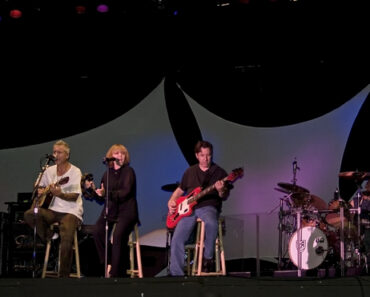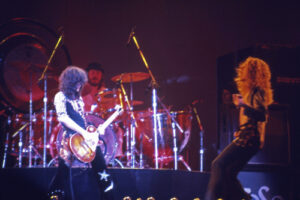
Feature Photo: cottonbro studio
Hope doesn’t always announce itself loudly. Sometimes, it hides between the lines, revealed only when we dig deeper into the lyrics and emotions that drive a song. This list isn’t your typical collection of obvious anthems about hope; instead, it offers a more nuanced exploration of what hope can mean in rock music. We’ve ventured off the beaten path, seeking tracks that don’t simply hand you their meaning but ask you to listen closer, think harder, and feel more deeply.
These songs capture hope in all forms—a flicker of light in a dark moment, a push through adversity, or even an ironic twist that challenges how we define hope. This list’s beauty lies in how each song presents the theme without following predictable formulas. By peeling back the layers of each track, we reveal the unexpected hope that emerges from the stories they tell. With this approach, we’ve compiled a list that is as interesting as it is inspiring, showcasing that hope is often found where we least expect it.
# 10 – Soulshine – The Allman Brothers Band
“Soulshine,” written by Warren Haynes and recorded by The Allman Brothers Band for their 1994 album Where It All Begins, captures the core message of finding hope and light in life’s darkest moments. Produced by legendary producer Tom Dowd at Criteria Studios in Miami, the track showcases Gregg Allman’s soulful vocals, Haynes’ powerful guitar work, and the tight rhythm section of Allen Woody on bass, Butch Trucks, and Jaimoe on drums. Although not released as a single, “Soulshine” became a live favorite, resonating deeply with fans, particularly due to its message of perseverance and inner strength. Haynes initially wrote the song for Larry McCray’s 1993 album Delta Hurricane, but the Allman Brothers’ version became a staple in their concerts.
Read More: Warren Haynes: The ClassicRockHistory.com Interview
Read More: Top 10 Allman Brothers Band Songs
# 9 – To The Open Spaces – Maria McKee
From her 2003 album High Dive, Maria McKee’s “To the Open Spaces” is a song that speaks to the themes of hope, freedom, and the bittersweet nature of life’s journey. Co-written with Jim Akin, the track captures the essence of moving forward despite the uncertainties of the future. The song, recorded at Rosehill House, Viewfinder Studios, and Zeitgeist, features McKee’s signature vocals alongside Akin’s multi-instrumental prowess, creating a soundscape that blends rock, folk, and orchestral elements. The combination of lap steel guitar, violin, cello, and brass adds depth and texture to the music, reflecting the emotional complexity of the lyrics.
Read More: 10 Maria McKee Songs That Will Leave You Mesmerized
# 8 – O-o-h Child – Laura Nyro
Laura Nyro’s rendition of “O-o-h Child,” from her 1971 album Gonna Take a Miracle, is a soulful and uplifting interpretation of the classic by The Five Stairsteps. This album, produced by the legendary team of Kenny Gamble and Leon Huff, features Nyro collaborating with the vocal powerhouse trio Labelle, creating a rich, harmonious blend of voices that encapsulates the essence of hope. Recorded at Sigma Sound Studios in Philadelphia, Gonna Take a Miracle showcases Nyro’s deep connection to the R&B and soul music of the 1950s and 1960s, with “O-o-h Child” being one of the standout tracks. This all-covers album remains one of Nyro’s most beloved works, and her heartfelt take on this song highlights the timeless theme of hope shining through adversity.
Read More: Top 10 Laura Nyro Songs
# 7 – Follow You Follow Me – Genesis
“Follow You Follow Me” by Genesis is a defining moment in the band’s career and one of their most hopeful, uplifting tracks. Released in 1978 on their ninth studio album, …And Then There Were Three…, the song was a notable departure from the band’s earlier, more progressive rock sound, leaning toward a more accessible pop-rock style. Recorded between September and October 1977 at Relight Studios in Hilvarenbeek, Netherlands, the album was produced by David Hentschel and Genesis themselves. The lineup for this song includes Phil Collins on drums and lead vocals, Tony Banks on keyboards, and Mike Rutherford on guitars and bass. With its gentle melody and heartfelt lyrics, “Follow You Follow Me” would go on to become Genesis’s first hit single in the United States, peaking at number 23 on the Billboard Hot 100 and reaching number 7 on the UK Singles Chart.
Read More: Top 10 Genesis Songs
# 6 – Move On Up – Curtis Mayfield
“Move On Up” by Curtis Mayfield is a timeless anthem of hope and resilience, embodying a message of perseverance in the face of life’s inevitable challenges. Released in 1970 on Mayfield’s debut solo album Curtis, this nearly nine-minute masterpiece brings together a vibrant mix of soul, funk, and socially conscious lyrics. Produced by Mayfield himself, the album was recorded at RCA Studios in Chicago, where Mayfield, coming off his success with The Impressions, sought to expand his musical vision. He enlisted a dynamic group of musicians, including Joseph “Lucky” Scott on bass, Master Henry Gibson on congas, and Donny Hathaway on piano. Together, they crafted a sound that was both lush and rhythmically tight, helping Mayfield deliver a message of hope and aspiration.
Read More: Top 10 Curtis Mayfield Songs
# 5 – Wild in the Streets – Garland Jeffreys
Wild in the Streets by Garland Jeffreys may not explicitly shout the word “hope,” but within its gritty, streetwise lyrics lies a message of resilience and defiance, an underlying theme of hope that emerges when we read between the lines. Originally released in 1973 and later re-recorded for his 1977 album Ghost Writer, this song resonates with the struggles of urban youth caught up in a harsh environment, yet striving for something greater. The rebellious energy and fierce determination embedded in the lyrics point to the possibility of escape, change, and ultimately, hope. It’s the kind of hope that isn’t always easily accessible—it’s a hard-earned hope born out of survival.
Read More: Top 10 Garland Jeffreys Songs
# 4 – I Hope That I Don’t Fall In Love With You – Tom Waits
Tom Waits’ I Hope That I Don’t Fall in Love with You from his 1973 debut album Closing Time is an evocative and wistful ballad that blends irony with a yearning sense of hope. The song, produced by Jerry Yester, takes the listener into a late-night bar scene where the protagonist wrestles with the fear and excitement of falling in love. The quiet, conversational tone of the song feels intimate, almost as if Waits is recounting a personal story over a beer, which fits perfectly with the somber mood of Closing Time, recorded in the relaxed atmosphere of Sunset Sound Recorders in Hollywood, California. The musicianship on this album, featuring Waits on vocals and piano, Doug Sax on bass, and John Seiter on drums, among others, adds to the warm yet melancholic feel that permeates the record.
Read More: Complete List Of Tom Waits Albums And Songs
# 3 – Something’s Happening – Peter Frampton
Peter Frampton’s “Something’s Happening” is the title track from his 1974 album, which marked a key moment in his musical journey before his career skyrocketed with Frampton Comes Alive!. Written and performed by Frampton, this song is infused with the unmistakable sound of hope and optimism, reflecting a newfound energy in both his songwriting and musical direction. Recorded at Olympic and Island Studios in London, as well as Headley Grange in Hampshire, the song captures Frampton’s signature guitar work and introspective lyrics, blending rock and melodic pop. Produced by Chris Kimsey, “Something’s Happening” introduces the theme of change and forward momentum, which resonates deeply with the idea of hope throughout the song’s lyrics.
Read More: Top 10 Peter Frampton Songs
# 2 – I Believe In Music – Gallery
Gallery’s rendition of “I Believe in Music” stands as one of the most hopeful and uplifting rock songs of the early 1970s. Originally penned by Mac Davis, this 1970 anthem became a signature song for him, but it was Gallery’s 1972 version that captured a broader audience. Released as a follow-up single to the hit “Nice to Be with You,” “I Believe in Music” was featured on the same album. Gallery’s take on the song embraced the spirit of optimism and unity that defined so much of the music of that era, resonating strongly with listeners in both the U.S. and Canada. It peaked at number 22 on the U.S. Billboard Hot 100 and number 5 in Canada, becoming one of the band’s more memorable hits.
Read More: 1972’s Best Classic Rock Albums
# 1 – The Promised Land – Bruce Springsteen
As the closing entry on this list of 10 essential rock songs about hope, Bruce Springsteen’s “The Promised Land” from Darkness on the Edge of Town embodies resilience, perseverance, and hope for a better tomorrow. Released in 1978, the song channels Springsteen’s knack for capturing the grit of working-class life and the unrelenting optimism that drives people to push forward despite their struggles. It’s a track that resonates deeply with those seeking not just survival but transcendence, and that message of fighting for something better is what makes this song such an iconic representation of hope.
Read More: Top 100 Bruce Springsteen Songs
Check out similar articles on ClassicRockHistory.com Just click on any of the links below……
10 Most Heartbreaking Rock Songs
10 Best Rock Songs About Stalkers
10 Best Songs About Cars
10 Best Rock Songs About Ghosts
10 Best Rock Songs About Depression
10 Best Rock Songs About Falling Out Of Love
10 Best Rock Songs About Being Bad
10 Best Rock Songs About Miracles
Updated July 21, 2025









































Nothing can touch the title track of Darkness on the Edge of Town
I agree, that song saved my life many years ago.